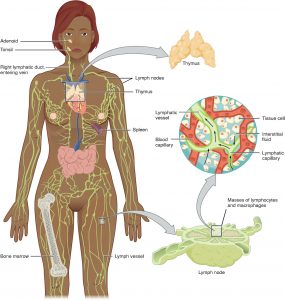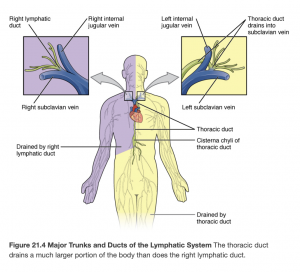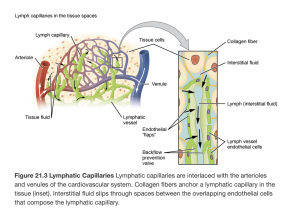Lymphatic System Assessment
Introduction to Lymphatic System
The lymphatic system (see Figure 1, 2, and 3 for an anatomical overview) includes lymphatic capillaries, lymphatic vessels, lymph nodes, and other lymphoid tissues. This system plays a valuable role in fluid balance and filtering pathogens and waste such as cellular debris. Assessment of the lymphatic system provides important information about the functioning of this system and potential cues that require further action.
The lymphatic system involves the following processes:
- Fluids and proteins leak from the vascular system into the . As previously discussed in the peripheral vascular chapter, much of this fluid is reabsorbed back into the venous system.
- Some of the fluid and proteins (including waste and pathogens) in the interstitial space are absorbed by the lymphatic capillaries into the lymphatic system, which becomes lymph (i.e., lymphatic fluid that is rich in proteins).
- The lymph travels along the so that fluid and proteins can be returned from the lymphatic system into the bloodstream to ensure sufficient blood volume in the cardiovascular system. The lymph is returned to the bloodstream through the right lymphatic duct and the thoracic duct into the subclavian veins. Attached to the lymphatic vessels are hundreds of lymph nodes throughout the body, which filter the lymph and cleanse it.
- Lymph nodes can be found all over the body and are often assessed in the head/neck, axilla, anterior chest, upper arm, and groin areas.
You have already learned about the anatomy and physiology of the lymphatic system, here is a quick overview of how it works: https://www.youtube.com/watch?v=QD9AdNXSQe4
An additional resource is this video: https://www.youtube.com/watchv=I7orwMgTQ5I&list=PL8dPuuaLjXtOAKed_MxxWBNaPno5h3Zs8&index=46
Clinical Tip

Figure 1: Overview of lymphatic system.

Figure 2: Lymphatic ducts.

Figure 3: Lymphatic capillaries.
(Attribution for all three images: Gordon Betts, J., Young, K.A., Wise, J.A., Johnson, E., Poe, B., Kruse, D.H., Korol, O., Johnson, J.E., Womble, M., & DeSaix, P. (2013). The Lymphatic and Immune System. In Anatomy and Physiology. OpenStax. Creative Commons Attribution License v4.0. Book URL: https://openstax.org/books/anatomy-and-physiology/pages/1-introduction
Section URL: https://openstax.org/books/anatomy-and-physiology/pages/21-1-anatomy-of-the-lymphatic-and-immune-systems)
Activity: Check Your Understanding
is the area that surrounds the vasculature and the body's tissues and organs in which fluid passes back and forth between capillaries and the tissue.
are a network of vessels throughout the body similar to the vascular network.

